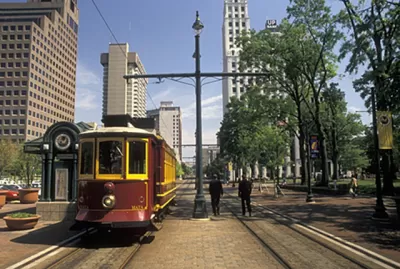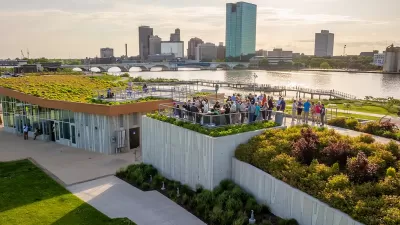The city of Memphis, Tennessee is in the middle of an understated boom focused on downtown development and adaptive reuse.

Memphis is booming, Patrick Sisson writes, and it's doing so largely in the context of the built environment it already has. "More than $13 billion in revitalization projects has reshaped Memphis's downtown over the past four years, and, according to Cushman & Wakefield/Commercial Advisors, tourism grew 13 percent between 2012 and 2017."
Adaptive reuse projects abound in this historical river port and shipping hub, with its ample supply of old warehouses and similar facilities. "Since the second-tier market has been slower to ramp up post-Recession, developers have had to be more thoughtful, deliberate, and thrifty, leading to an outsize focus on adaptive reuse," Sisson says.
In addition to an expanding transit system, Memphis' shift back downtown has spurred the development of bike infrastructure. "In a spread-out landscape lacking transit access and sufficient bus service—trolleys cover a small fraction of the city—a rapid investment in cycling infrastructure has made significant inroads. According to the Memphis Flyer, the city went from 1.5 miles of bike lanes in 2010 to 400-plus miles of bike-friendly thoroughfares today."
Green space is another priority. To reclaim the city's riverfront for residents, an expected $75 million development including a network of waterfront parks is currently in the works.
FULL STORY: Memphis downtown boom fueled by riverfront city’s rich history

Maui's Vacation Rental Debate Turns Ugly
Verbal attacks, misinformation campaigns and fistfights plague a high-stakes debate to convert thousands of vacation rentals into long-term housing.

Planetizen Federal Action Tracker
A weekly monitor of how Trump’s orders and actions are impacting planners and planning in America.

San Francisco Suspends Traffic Calming Amidst Record Deaths
Citing “a challenging fiscal landscape,” the city will cease the program on the heels of 42 traffic deaths, including 24 pedestrians.

Defunct Pittsburgh Power Plant to Become Residential Tower
A decommissioned steam heat plant will be redeveloped into almost 100 affordable housing units.

Trump Prompts Restructuring of Transportation Research Board in “Unprecedented Overreach”
The TRB has eliminated more than half of its committees including those focused on climate, equity, and cities.

Amtrak Rolls Out New Orleans to Alabama “Mardi Gras” Train
The new service will operate morning and evening departures between Mobile and New Orleans.
Urban Design for Planners 1: Software Tools
This six-course series explores essential urban design concepts using open source software and equips planners with the tools they need to participate fully in the urban design process.
Planning for Universal Design
Learn the tools for implementing Universal Design in planning regulations.
Heyer Gruel & Associates PA
JM Goldson LLC
Custer County Colorado
City of Camden Redevelopment Agency
City of Astoria
Transportation Research & Education Center (TREC) at Portland State University
Jefferson Parish Government
Camden Redevelopment Agency
City of Claremont





























